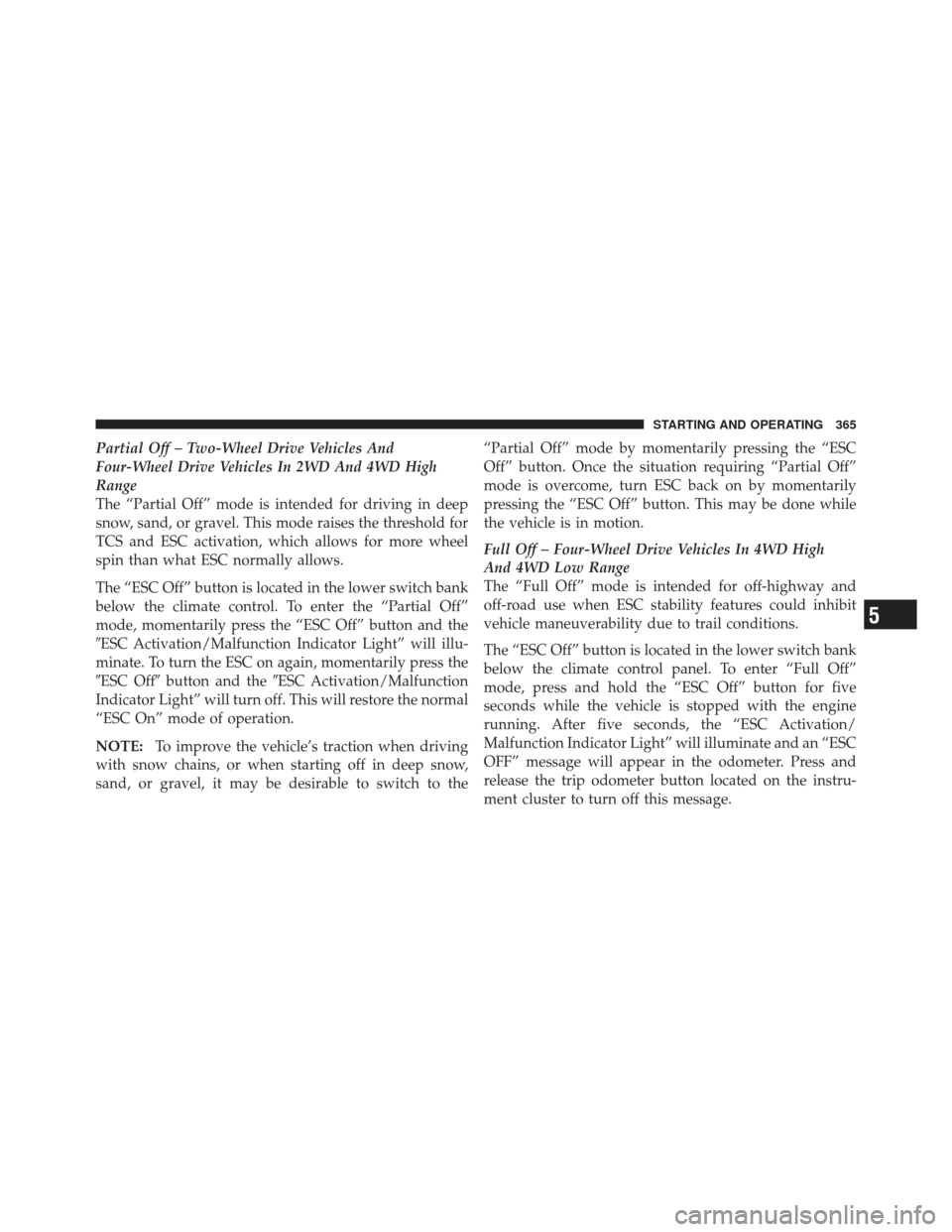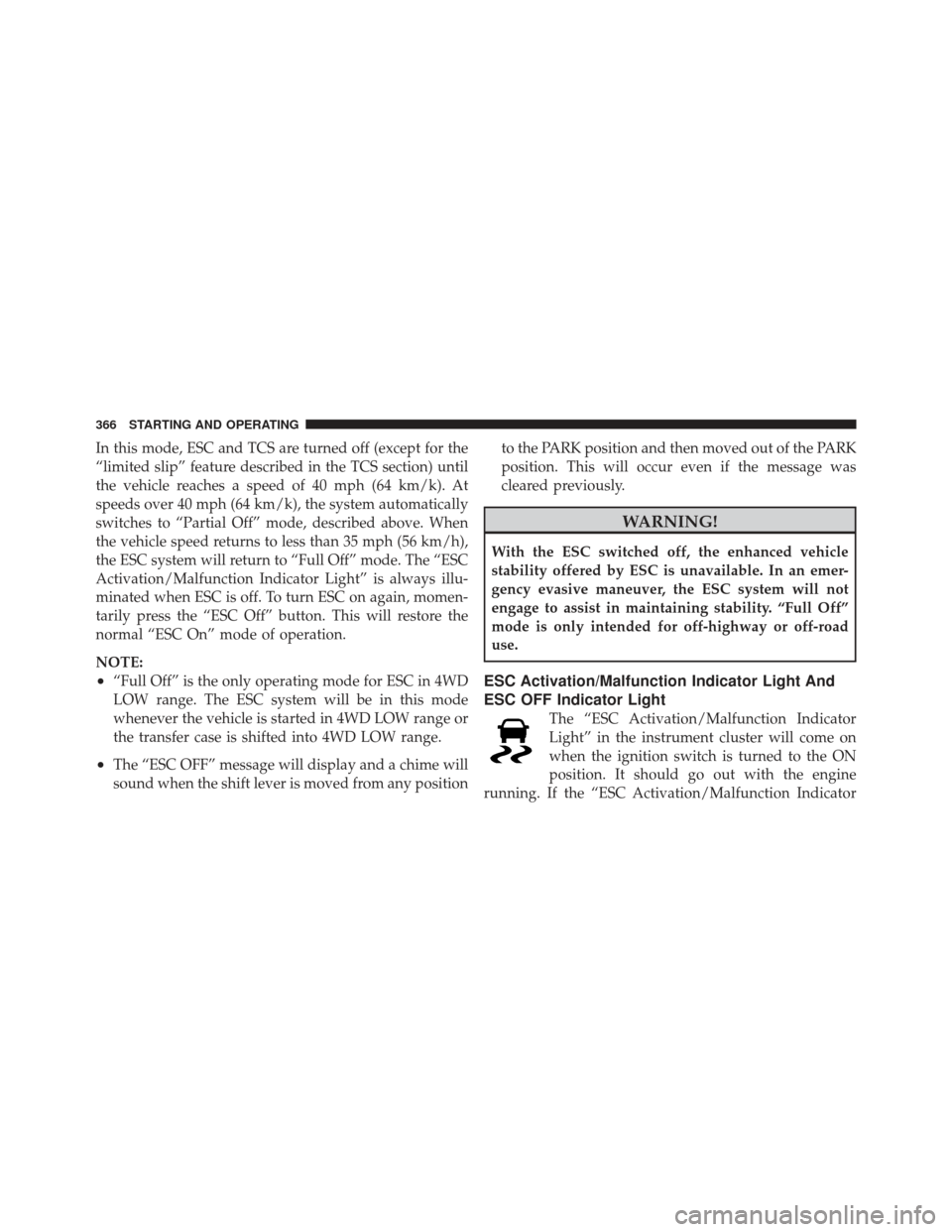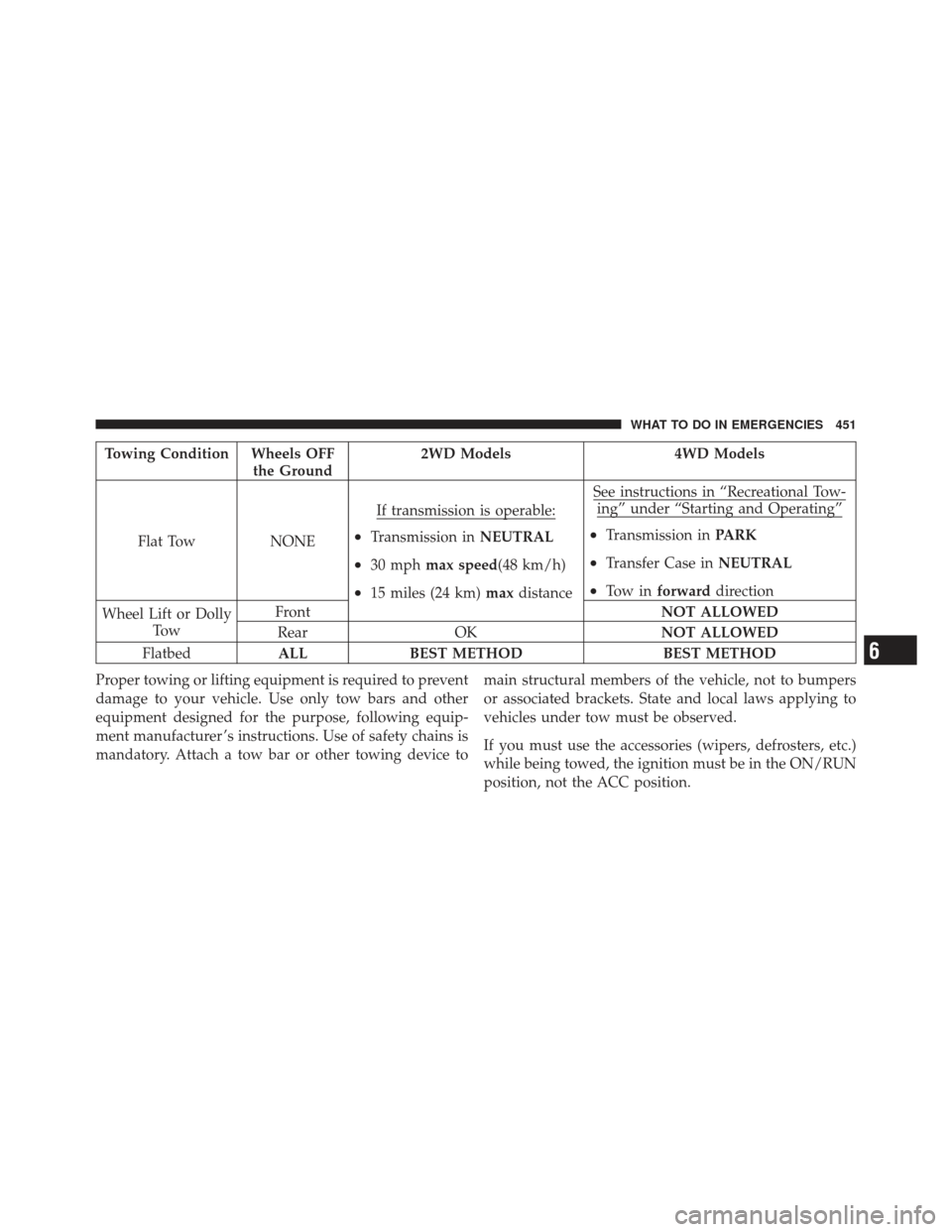Page 364 of 558
HDC control speed. If more speed is desired during HDC
control, the accelerator pedal will increase vehicle speed
in the usual manner. When either the brake or the
accelerator is released, HDC will control the vehicle at the
original set speed.
NOTE:HDC is available on vehicles equipped with the
MP1522 transfer case.
•The transfer case must be in 4WD LOW range to
enable HDC.
•HDC is enabled only when the “Hill Descent Control
Indicator Light” in the instrument cluster is on solid.
•HDC will NOT activate when the automatic transmis-
sion is in PARK.
•HDC will NOT activate on level ground.
•HDC will NOT activate at vehicle speeds above
30 mph (50 km/h). The “Hill Descent” button is located in the lower switch
bank below the climate control.
Enabling HDC
1. Shift the transfer case into 4WD LOW range. Refer to
“Four-Wheel Drive Operation” in “Starting and Operat-
ing” for further information.
Hill Descent Button
362 STARTING AND OPERATING
Page 365 of 558

2. Press the “Hill Descent” button. The “Hill Descent
Control Indicator Light” in the instrument cluster will
turn on solid.
NOTE:If the transfer case is not in 4WD LOW range,
the “Hill Descent Control Indicator Light” will flash for
five seconds and HDC will not be enabled.
Disabling HDC
1. Press the “Hill Descent” button or shift the transfer
case out of 4WD LOW range. The “Hill Descent Control
Indicator” light in the instrument cluster will turn off.
Electronic Stability Control (ESC)
This system enhances directional control and stability of
the vehicle under various driving conditions. ESC cor-
rects for oversteering or understeering of the vehicle by
applying the brake of the appropriate wheel to assist in counteracting the oversteer or understeer condition. En-
gine power may also be reduced to help the vehicle
maintain the desired path.
ESC uses sensors in the vehicle to determine the vehicle
path intended by the driver and compares it to the actual
path of the vehicle. When the actual path does not match
the intended path, ESC applies the brake of the appro-
priate wheel to assist in counteracting the oversteer or
understeer condition.
•Oversteer - when the vehicle is turning more than
appropriate for the steering wheel position.
•Understeer - when the vehicle is turning less than
appropriate for the steering wheel position.
The “ESC Activation/Malfunction Indicator Light” lo-
cated in the instrument cluster will start to flash as soon
as the tires lose traction and the ESC system becomes
active. The “ESC Activation/Malfunction Indicator
5
STARTING AND OPERATING 363
Page 366 of 558

Light” also flashes when the TCS is active. If the “ESC
Activation/Malfunction Indicator Light” begins to flash
during acceleration, ease up on the accelerator and apply
as little throttle as possible. Be sure to adapt your speed
and driving to the prevailing road conditions.
WARNING!
The Electronic Stability Control (ESC) cannot pre-
vent the natural laws of physics from acting on the
vehicle, nor can it increase the traction afforded by
prevailing road conditions. ESC cannot prevent col-
lisions, including those resulting from excessive
speed in turns, driving on very slippery surfaces, or
hydroplaning. The capabilities of an ESC equipped
vehicle must never be exploited in a reckless or
dangerous manner which could jeopardize the user ’s
safety or the safety of others.
ESC Operating Modes
Depending upon model and mode of operation, the ESC
system has up to three operating modes: “ESC On”
“Partial Off,” and “Full Off.”
ESC On – Two-Wheel Drive Vehicles And Four-Wheel
Drive Vehicles In 2WD And 4WD High Range
This is the normal operating mode for ESC when oper-
ating a two-wheel drive vehicle. It is also the normal
mode for operating a four-wheel drive vehicle in 2WD or
4WD HIGH range. The ESC system will be in “ESC On”
mode whenever the vehicle is started or the transfer case
(if equipped) is shifted out of 4WD LOW range. This
mode should be used for most driving situations. ESC
should only be turned to “Partial Off” or “Full Off” for
specific reasons as noted. Refer to “Partial Off” and to
“Full Off” for additional information.
364 STARTING AND OPERATING
Page 367 of 558

Partial Off – Two-Wheel Drive Vehicles And
Four-Wheel Drive Vehicles In 2WD And 4WD High
Range
The “Partial Off” mode is intended for driving in deep
snow, sand, or gravel. This mode raises the threshold for
TCS and ESC activation, which allows for more wheel
spin than what ESC normally allows.
The “ESC Off” button is located in the lower switch bank
below the climate control. To enter the “Partial Off”
mode, momentarily press the “ESC Off” button and the
�ESC Activation/Malfunction Indicator Light” will illu-
minate. To turn the ESC on again, momentarily press the
�ESC Off�button and the �ESC Activation/Malfunction
Indicator Light” will turn off. This will restore the normal
“ESC On” mode of operation.
NOTE: To improve the vehicle’s traction when driving
with snow chains, or when starting off in deep snow,
sand, or gravel, it may be desirable to switch to the “Partial Off” mode by momentarily pressing the “ESC
Off” button. Once the situation requiring “Partial Off”
mode is overcome, turn ESC back on by momentarily
pressing the “ESC Off” button. This may be done while
the vehicle is in motion.
Full Off – Four-Wheel Drive Vehicles In 4WD High
And 4WD Low Range
The “Full Off” mode is intended for off-highway and
off-road use when ESC stability features could inhibit
vehicle maneuverability due to trail conditions.
The “ESC Off” button is located in the lower switch bank
below the climate control panel. To enter “Full Off”
mode, press and hold the “ESC Off” button for five
seconds while the vehicle is stopped with the engine
running. After five seconds, the “ESC Activation/
Malfunction Indicator Light” will illuminate and an “ESC
OFF” message will appear in the odometer. Press and
release the trip odometer button located on the instru-
ment cluster to turn off this message.
5
STARTING AND OPERATING 365
Page 368 of 558

In this mode, ESC and TCS are turned off (except for the
“limited slip” feature described in the TCS section) until
the vehicle reaches a speed of 40 mph (64 km/k). At
speeds over 40 mph (64 km/k), the system automatically
switches to “Partial Off” mode, described above. When
the vehicle speed returns to less than 35 mph (56 km/h),
the ESC system will return to “Full Off” mode. The “ESC
Activation/Malfunction Indicator Light” is always illu-
minated when ESC is off. To turn ESC on again, momen-
tarily press the “ESC Off” button. This will restore the
normal “ESC On” mode of operation.
NOTE:
•“Full Off” is the only operating mode for ESC in 4WD
LOW range. The ESC system will be in this mode
whenever the vehicle is started in 4WD LOW range or
the transfer case is shifted into 4WD LOW range.
•The “ESC OFF” message will display and a chime will
sound when the shift lever is moved from any positionto the PARK position and then moved out of the PARK
position. This will occur even if the message was
cleared previously.
WARNING!
With the ESC switched off, the enhanced vehicle
stability offered by ESC is unavailable. In an emer-
gency evasive maneuver, the ESC system will not
engage to assist in maintaining stability. “Full Off”
mode is only intended for off-highway or off-road
use.
ESC Activation/Malfunction Indicator Light And
ESC OFF Indicator Light
The “ESC Activation/Malfunction Indicator
Light” in the instrument cluster will come on
when the ignition switch is turned to the ON
position. It should go out with the engine
running. If the “ESC Activation/Malfunction Indicator
366 STARTING AND OPERATING
Page 453 of 558

Towing Condition Wheels OFFthe Ground 2WD Models
4WD Models
Flat Tow NONEIf transmission is operable:
•Transmission in
NEUTRAL
•30 mphmax speed(48 km/h)
•15 miles (24 km) maxdistance See instructions in “Recreational Tow-
ing” under “Starting and Operating”
•Transmission in
PARK
•Transfer Case in NEUTRAL
•To w i nforward direction
Wheel Lift or Dolly To w Front
NOT ALLOWED
Rear OK NOT ALLOWED
Flatbed ALL BEST METHOD BEST METHOD
Proper towing or lifting equipment is required to prevent
damage to your vehicle. Use only tow bars and other
equipment designed for the purpose, following equip-
ment manufacturer ’s instructions. Use of safety chains is
mandatory. Attach a tow bar or other towing device to main structural members of the vehicle, not to bumpers
or associated brackets. State and local laws applying to
vehicles under tow must be observed.
If you must use the accessories (wipers, defrosters, etc.)
while being towed, the ignition must be in the ON/RUN
position, not the ACC position.
6
WHAT TO DO IN EMERGENCIES 451
Page:
< prev 1-8 9-16 17-24